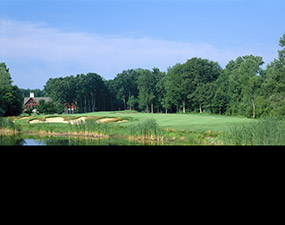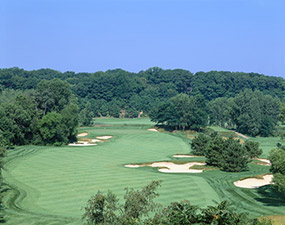An apparently natural marriage between a young minimalist architect and the sand dunes of the Michigan shoreline, the Lost Dunes Golf Club was, in reality, one of the most complex and unlikely success stories of the 1990s. Founded by businessman Jeff Shearer, the club is located in the south-west corner of the state, less than a half-mile from Lake Michigan but built within an abandoned sand mine and split by a busy Interstate highway. After considering a number of more experienced architects, Shearer chose an enthusiastic local named Tom Doak as his designer. The decision was the making of the golf club.
Doak arranged the first seven holes on the inland side of the highway, with the remainder of the course set on the main property where three pit lakes are a prominent feature. Although the site had a fertile sandy base, the mined areas were mostly flat and far from ideal for golf. Unperturbed, Doak skillfully managed to route a unique yet intelligent and coherent layout across the difficult and disjointed landscape. The greens, in particular, are excellent and fascinating both for their daring contours and the manner in which they were created. Formed in partnership with Mother Nature, Doak roughly shaped his targets but then let the wind blow the topsoil around for a few weeks before he grassed them. Some slopes may seem a little extreme, but they all fit nicely with the shot required and the variety of recovery options is first-class. As at Ballyneal and Barnbougle Dunes, here missed greens are often followed by a sideways pitch or chip with the ball fed back off a slope toward the hole.
Early highlights include superb fairway bunkering on the first two holes, the heavy undulations of the 3rd and 4th greens and strong, strategic two-shotters at the 6th and 7th. On the main paddock water holes are well integrated into the layout, particularly at the reachable par five 10th where a cascading green shape is guarded by a pond but still tempts players to take a gamble from back in the fairway. The most exciting approach, however, is the one played into the split-level 11th green, which falls steeply to the left and rests in a naturally elevated saddle. The next hole drops more than 50 feet and features subtle green contours that create clear choices from the tee. The multi-route 17th and par five 15th, which sweeps around a lake and up into a heavily bunkered hillock, are also noteworthy.
Throughout the round there is a nice flow with the birdie opportunities and torture tests spread evenly across both nines. Fairway widths are generous, yet driving into ideal areas generally means taking a risk from the tee. The classically rugged bunker shapes are also strategic, and varied with the small trap standing sentinel short of the brilliant 6th green proving just as effective at creating uncertainty as the deep beast guarding the target on the 11th.
Tom Doak has established an enviable reputation for producing memorable courses that are playable to a range of skill levels, and again at Lost Dunes he rewards good shots with birdie putts and only punishes those that are poorly planned or executed. Although the course is unlikely to win the sort of accolades bestowed upon his more spectacular creations, this is a tremendous achievement which, given the restrictions, must rank among the most impressive built by this architectural Renaissance man.

 this course also has exceptional:
this course also has exceptional:

